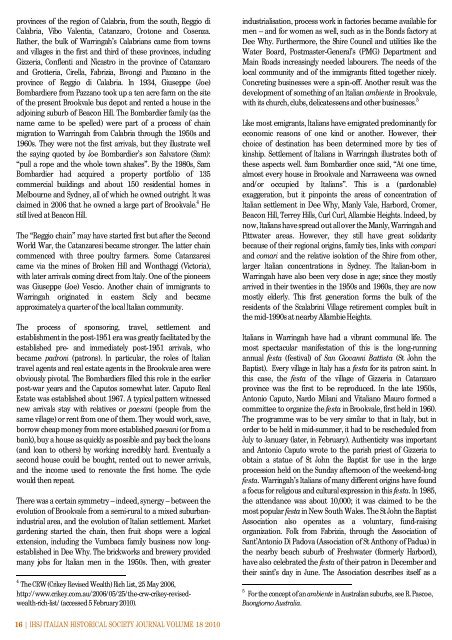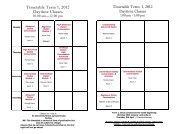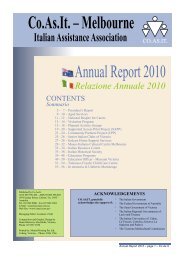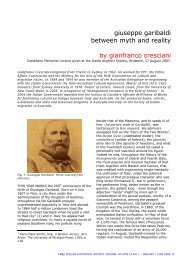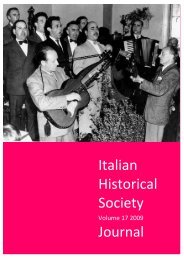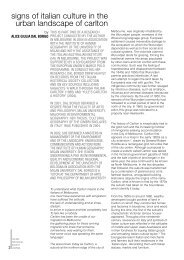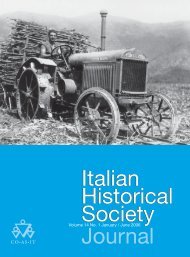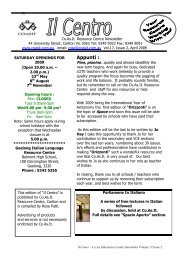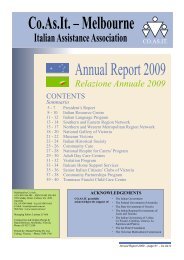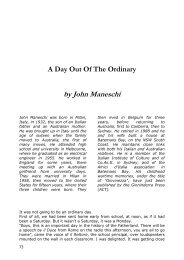January-December 2010, vol. 1
January-December 2010, vol. 1
January-December 2010, vol. 1
- No tags were found...
You also want an ePaper? Increase the reach of your titles
YUMPU automatically turns print PDFs into web optimized ePapers that Google loves.
provinces of the region of Calabria, from the south, Reggio diCalabria, Vibo Valentia, Catanzaro, Crotone and Cosenza.Rather, the bulk of Warringah’s Calabrians came from townsand villages in the first and third of these provinces, includingGizzeria, Conflenti and Nicastro in the province of Catanzaroand Grotteria, Cirella, Fabrizia, Bivongi and Pazzano in theprovince of Reggio di Calabria. In 1934, Giuseppe (Joe)Bombardiere from Pazzano took up a ten acre farm on the siteof the present Brookvale bus depot and rented a house in theadjoining suburb of Beacon Hill. The Bombardier family (as thename came to be spelled) were part of a process of chainmigration to Warringah from Calabria through the 1950s and1960s. They were not the first arrivals, but they illustrate wellthe saying quoted by Joe Bombardier’s son Salvatore (Sam):“pull a rope and the whole town shakes”. By the 1980s, SamBombardier had acquired a property portfolio of 135commercial buildings and about 150 residential homes inMelbourne and Sydney, all of which he owned outright. It wasclaimed in 2006 that he owned a large part of Brookvale. 4 Hestill lived at Beacon Hill.The “Reggio chain” may have started first but after the SecondWorld War, the Catanzaresi became stronger. The latter chaincommenced with three poultry farmers. Some Catanzaresicame via the mines of Broken Hill and Wonthaggi (Victoria),with later arrivals coming direct from Italy. One of the pioneerswas Giuseppe (Joe) Vescio. Another chain of immigrants toWarringah originated in eastern Sicily and becameapproximately a quarter of the local Italian community.The process of sponsoring, travel, settlement andestablishment in the post-1951 era was greatly facilitated by theestablished pre- and immediately post-1951 arrivals, whobecame padroni (patrons). In particular, the roles of Italiantravel agents and real estate agents in the Brookvale area wereobviously pivotal. The Bombardiers filled this role in the earlierpost-war years and the Caputos somewhat later. Caputo RealEstate was established about 1967. A typical pattern witnessednew arrivals stay with relatives or paesani (people from thesame village) or rent from one of them. They would work, save,borrow cheap money from more established paesani (or from abank), buy a house as quickly as possible and pay back the loans(and loan to others) by working incredibly hard. Eventually asecond house could be bought, rented out to newer arrivals,and the income used to renovate the first home. The cyclewould then repeat.There was a certain symmetry – indeed, synergy – between thee<strong>vol</strong>ution of Brookvale from a semi-rural to a mixed suburbanindustrialarea, and the e<strong>vol</strong>ution of Italian settlement. Marketgardening started the chain, then fruit shops were a logicalextension, including the Vumbaca family business now longestablishedin Dee Why. The brickworks and brewery providedmany jobs for Italian men in the 1950s. Then, with greater4 The CRW (Crikey Revised Wealth) Rich List, 25 May 2006,http://www.crikey.com.au/2006/05/25/the-crw-crikey-revisedwealth-rich-list/(accessed 5 February <strong>2010</strong>).industrialisation, process work in factories became available formen – and for women as well, such as in the Bonds factory atDee Why. Furthermore, the Shire Council and utilities like theWater Board, Postmaster-General’s (PMG) Department andMain Roads increasingly needed labourers. The needs of thelocal community and of the immigrants fitted together nicely.Concreting businesses were a spin-off. Another result was thedevelopment of something of an Italian ambiente in Brookvale,with its church, clubs, delicatessens and other businesses. 5Like most emigrants, Italians have emigrated predominantly foreconomic reasons of one kind or another. However, theirchoice of destination has been determined more by ties ofkinship. Settlement of Italians in Warringah illustrates both ofthese aspects well. Sam Bombardier once said, “At one time,almost every house in Brookvale and Narraweena was ownedand/or occupied by Italians”. This is a (pardonable)exaggeration, but it pinpoints the areas of concentration ofItalian settlement in Dee Why, Manly Vale, Harbord, Cromer,Beacon Hill, Terrey Hills, Curl Curl, Allambie Heights. Indeed, bynow, Italians have spread out all over the Manly, Warringah andPittwater areas. However, they still have great solidaritybecause of their regional origins, family ties, links with compariand comari and the relative isolation of the Shire from other,larger Italian concentrations in Sydney. The Italian-born inWarringah have also been very close in age; since they mostlyarrived in their twenties in the 1950s and 1960s, they are nowmostly elderly. This first generation forms the bulk of theresidents of the Scalabrini Village retirement complex built inthe mid-1990s at nearby Allambie Heights.Italians in Warringah have had a vibrant communal life. Themost spectacular manifestation of this is the long-runningannual festa (festival) of San Giovanni Battista (St John theBaptist). Every village in Italy has a festa for its patron saint. Inthis case, the festa of the village of Gizzeria in Catanzaroprovince was the first to be reproduced. In the late 1950s,Antonio Caputo, Nardo Milani and Vitaliano Mauro formed acommittee to organize the festa in Brookvale, first held in 1960.The programme was to be very similar to that in Italy, but inorder to be held in mid-summer, it had to be rescheduled fromJuly to <strong>January</strong> (later, in February). Authenticity was importantand Antonio Caputo wrote to the parish priest of Gizzeria toobtain a statue of St John the Baptist for use in the largeprocession held on the Sunday afternoon of the weekend-longfesta. Warringah’s Italians of many different origins have founda focus for religious and cultural expression in this festa. In 1985,the attendance was about 10,000; it was claimed to be themost popular festa in New South Wales. The St John the BaptistAssociation also operates as a <strong>vol</strong>untary, fund-raisingorganization. Folk from Fabrizia, through the Association ofSant’Antonio Di Padova (Association of St Anthony of Padua) inthe nearby beach suburb of Freshwater (formerly Harbord),have also celebrated the festa of their patron in <strong>December</strong> andtheir saint’s day in June. The Association describes itself as a5 For the concept of an ambiente in Australian suburbs, see R. Pascoe,Buongiorno Australia.16 | IHSJ ITALIAN HISTORICAL SOCIETY JOURNAL VOLUME 18 <strong>2010</strong>


